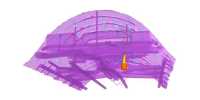More than the medium-sized state – and fast-growing – the U.S. has 1.8 percent of its electricity demand for data centers. However, a team of scientists has proposed a solution that could turn it around, creating all these number-crunching work for the planet, not the other way around. It can save so much money that everyone can share these benefits without investing in fossil fuels.
The battle between renewable energy and fossil fuels will determine the fate of our planet. In addition to not producing climate-friendly and deadly pollution, solar and wind now produce electricity cheaper than coal or gas in most parts of the world, unless the cost of storage needs to be included.
In addition to the ongoing search for cheap batteries, the most recommended solution is to improve the long-distance transmission of electricity. But Sangwan Su, a professor in the Santa Barbara Department at the University of California,
Berkeley thinks it’s better to send electricity where it’s cheaper and cleaner than to send it. This is often not practical. For example, there is no point in turning on the streetlights on a sunny day, only that sunlight is generating a lot of electricity.
Suh, however, made it clear that data processing is a different matter. Some data centers are already located in places like Iceland, so they can be powered by geothermal energy and hydroelectricity. Still, Sue is proposing something more sophisticated. At that time, data processing would be rolled out around the world to take advantage of cheap, cleanups wherever they occur. Data and data transport is very cheap because we can use fiber optics to transmit data literally at the speed of light.
Keep this in mind, the idea seems so clear that surprisingly it’s not already happening. Instead, the opposite has happened, at least in the United States, where the highest concentration of data centers is in North Virginia, one of the country&’s coal-dominated grids, which Sue calls the farthest electricity we can imagine. It even brings down the potential impact. In places where solar or wind power is already plentiful, electricity prices are falling at the sunniest or windy times due to oversupply. This is becoming the biggest threat to further expansion
of renewable energy in the most suitable places.
In July, Suh calculates that running bits, not watts" can prevent the equivalent emission of about one million tons of carbon dioxide per year when the sun is shining in California without even expanding California’s data centers. In addition, avoiding carbon dioxide per ton can save more than $200 on electricity costs.
Taking advantage of clean but intermittent energy hotspots like wind lightning in the Great Plains can make the advantage even greater. “I wondered why we hadn’t done this before,” Sue said. The answer seems to be that the owners of different information centers are reluctant to cooperate even if it is for their mutual benefit. If they could get past it, they could provide a big
leg-up for renewable energy and a drop in the heart of coal.














